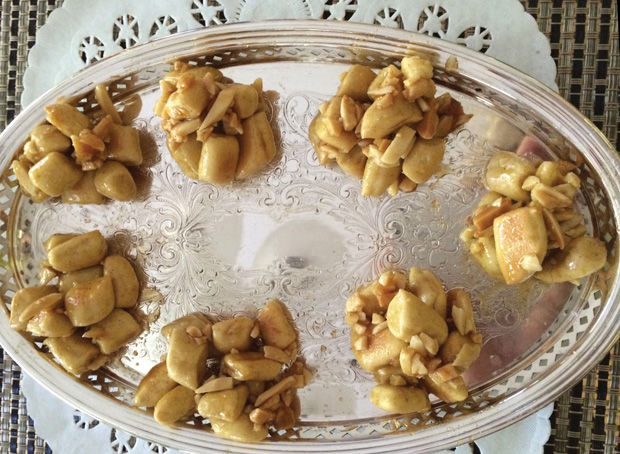Tayglach: An ancient Jewish holiday tradition
Published September 10, 2014
Honey is a classic symbol on the High Holidays. Its presence in different parts of our holiday menu signifies hope for a sweet New Year. And while many of us may incorporate honey into a tzimmes, the traditional cake, or as a dip for apple slices, a small number of Jews around the world use honey to prepare a little known pastry with its roots in ancient Ashkenazi and Sephardic traditions: tayglach.
Our 12th-century ancestors would have been far more familiar with this pastry than most of us. Indeed, until recently, I had never even heard of it.
According to Gil Marks, Jewish cookbook author and food historian, the Jews of the Roman Empire prepared a fried pastry called vermiculos. During the Middle Ages, French and German Jews renamed it vermesal and enjoyed it on the Sabbath. Later embraced by Lithuanian, Italian and Eastern European Jews, this pastry became a traditional Rosh Hashanah treat.
ADVERTISEMENT
Whether spelled teiglach, tayglach, taiglach, or teyglakh by Ashkenazi Jews or called pinyonati by Sephardic Jews or ceciarchiata by Italian Jews, this pastry’s basic elements are similar around the Jewish world: Pieces of egg-enriched dough are fried, boiled or baked, and then bathed in a rich honey syrup. Sounds amazing, doesn’t it? Having made a batch last week, I can guarantee this is one pastry you won’t want to miss. Intensely sweet and absolutely divine, it is the perfect honey treat with which to usher in the Jewish New Year.
I owe my discovery of tayglach to Stephen Cohen, vice president of planning and allocations for the Jewish Federation of St. Louis. Cohen mentioned tayglach to me during a conversation we had regarding cultural traditions. Curious to learn more, I asked him to share his memories of this pastry as a child growing up in Johannesburg, South Africa.
For Cohen, tayglach on Rosh Hashanah were as significant as hamentaschen are to most of us on Purim.
“My bubbe made tayglach on both Rosh Hashanah and Pesach,” he said.
“Her Rosh Hashanah tayglach were 2½ inches round and filled with raisins,” he said with a smile. “I remember loving how the honey coating made my fingers sticky. We would conclude our holiday meal by breaking off pieces of tayglach while sipping cups of Russian black tea. I really miss that.”`
ADVERTISEMENT
Rene Price, a St. Louis friend of Cohen’s who is also from Johannesburg, has not had tayglach in years. Other than the few years she made them herself, or the occasional times she brought them back from Johannesburg, Price had been unable to find them, much less find anyone who had even heard of them.
“I will never forget watching my bubba make tayglach before Rosh Hashanah,” Price said. “As a little girl, I would be allowed to sit on the kitchen table for a better view. After she made the dough and formed it into donut shapes, my bubba would drop them into her enormous soup pot of hot syrup to cook. She covered the pot with a lid and, almost immediately, the room became warm and steamy. We weren’t allowed to open the kitchen door for fear of losing that fragrant warmth.
“Just before the tayglach were ready, my bubba would sprinkle coconut and sugar onto a large board on the table. Using a wooden spoon, she transferred the tayglach from the pot to the prepared board, turning the sticky rounds to evenly coat both sides. Once the pastry cooled, my sister and I were permitted to scrape the excess honey off the board. I remember getting a blister once on the tip of my finger because I didn’t wait long enough!”
Price’s family had their tayglach at 4 in the afternoon with a cup of tea. They would eat them until none were left.
While you certainly won’t find tayglach in St. Louis, a few bakeries in New York continue to make them. One is Chiffon Kosher Bakery in Brooklyn (shopchiffons.com). Levi, the owner, was kind enough to talk with me about it.
“We’ve been making tayglach since the bakery became a kosher bakery some 35 years ago,” Levi said. “Though our tayglach clientele are primarily old timers of Ashkenazi descent, they are delighted to know we still make them.”
Levi attributes his dwindling tayglach customer base to the fact that so many Rosh Hashanah traditions have faded.
“Fewer young people know about this pastry,” he said, “or perhaps they spurn them in the interest of good health.”
Chiffon’s tayglach are simmered in honey syrup, formed into balls and, once cooled, stuck together into blocks or pyramids. At home, they can be pulled apart by hand or cut into pieces with a knife.“
Having learned about tayglach and its beloved heritage, and knowing that the closest bakeries for these pastries are all a plane flight away, I knew I had to try to bake a batch. Of course, I first had to find a reliable recipe. After studying the recipes in at least 20 Jewish cookbooks and food columns, I finally came up with my own recipe for this ancient holiday treat. Though my recipe is not complicated, if you decide to give it a try, make sure you set aside a two-hour block of time to make your tayglach.
L’shanah tova.
Margi Lenga Kahn is the mother of five and grandmother of five. A cooking instructor at the Kitchen Conservatory, she is working on a project to preserve the stories and recipes of heritage cooks. She welcomes your comments and suggestions at [email protected].
















